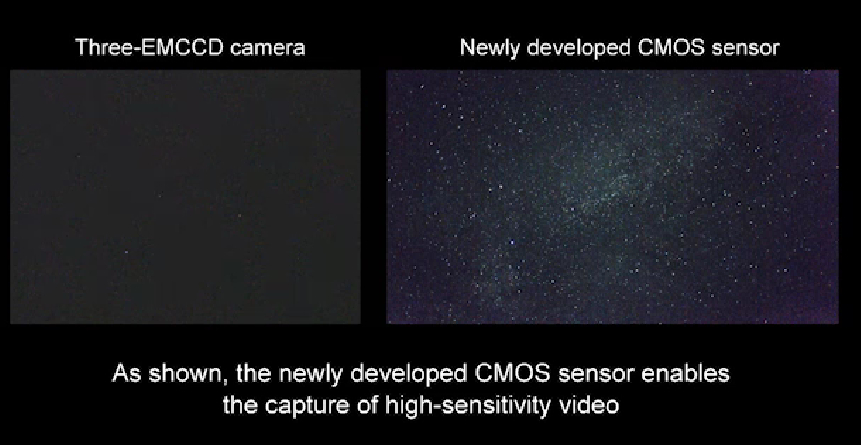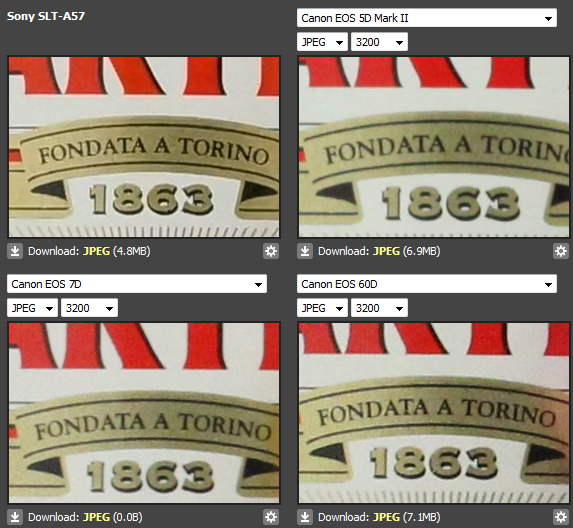It looks like you're using an Ad Blocker.
Please white-list or disable AboveTopSecret.com in your ad-blocking tool.
Thank you.
Some features of ATS will be disabled while you continue to use an ad-blocker.
7
share:
Hi All
This may be of interest to our astrophotography/video fans on here see the link for some info
It's a new low light sensor far more sensitive than current sensors.
Canon low light video sensor
You can click the link under the pictures on site above to see a test video.
Still from video
Normal video sensor v new low light video sensor

This may be of interest to our astrophotography/video fans on here see the link for some info
It's a new low light sensor far more sensitive than current sensors.
Canon low light video sensor
You can click the link under the pictures on site above to see a test video.
Still from video
Normal video sensor v new low light video sensor

Cool!
Now....how many mortages will I have to have on my home to buy the camera when it comes out?
Now....how many mortages will I have to have on my home to buy the camera when it comes out?
I was just thinking about getting the 60D maybe I will hold off. However I doubt I could afford a full frame camera, so perhaps they will spin this
off to the pro-sumer market.
Originally posted by abeverage
I was just thinking about getting the 60D maybe I will hold off. However I doubt I could afford a full frame camera, so perhaps they will spin this off to the pro-sumer market.
lets just stay focused on the 60d for now,the 5d mark 3 is like 5 grand
Originally posted by SPECULUM
Originally posted by abeverage
I was just thinking about getting the 60D maybe I will hold off. However I doubt I could afford a full frame camera, so perhaps they will spin this off to the pro-sumer market.
lets just stay focused on the 60d for now,the 5d mark 3 is like 5 grand
Geez I know! I could really use that angled view screen though! Got's a T2i right now.
I am a fan of Canon, used their SLR for gig photography because it performs well in low light with almost no digital noise, and the colours are softer
and nicer. So I'm happy to see they are developing better low-light technologies and open new markets. It's just a shame that there are no Canon
cameras on the ISS.
Looking forward to astronomy videos shot using the new sensor. I think it will produce some great timelapses of comets and asteroids flying by.
Looking forward to astronomy videos shot using the new sensor. I think it will produce some great timelapses of comets and asteroids flying by.
Im a hardened fan of Canon. Just been at the Focus on Imaging Camera show at the NEC Birmingham all day today
They make some excellent low light equipment.
They make some excellent low light equipment.
edit on 4-3-2013 by PhoenixOD because: (no reason given)
Nikon for life Althought if I'd buy a video camera instead of dslr I might consider the C-word.
reply to post by wmd_2008
Amazing! I'd love one (or half a dozen) of these!
But as eriktheawful says, how much?
Here's footage of a Perseid meteor from a three- EM CCD chip cooled video camera that cost around €44 000 (57,351 USD). That figure might be a little old but I doubt the price has come down very much.
This new sensor certainly isn't going to be cheap, and I suspect it might be a while till we see these on the shelves...
ETA: It caught my eye that Panasonic has also recently announced a new sensor technology which will alow more sensitivity, but not quite as much as Canon's:
Source: dpreview.com
Amazing! I'd love one (or half a dozen) of these!
But as eriktheawful says, how much?
Here's footage of a Perseid meteor from a three- EM CCD chip cooled video camera that cost around €44 000 (57,351 USD). That figure might be a little old but I doubt the price has come down very much.
This new sensor certainly isn't going to be cheap, and I suspect it might be a while till we see these on the shelves...
ETA: It caught my eye that Panasonic has also recently announced a new sensor technology which will alow more sensitivity, but not quite as much as Canon's:
Panasonic has devised a method to increase the sensitivity of image sensors, by replacing the near-universal colour filter array with prism-like 'Micro Color Splitters' to generate colour information. The key advantage is that all of the incoming light is directed to the sensor, instead of half or more being absorbed by the colour filter dyes. This promises to deliver images with less noise in low light. The development is published in the journal Nature Photonics, and outlined in a press release on Panasonic's website.
According to Panasonic, the dyes used in conventional colour filter arrays absorb at least half of the incoming light before it reaches the sensor's photosites. In contrast, the company's 'Micro Color Splitter' technology passes all of the incoming light to the sensor. In practical terms, this corresponds to a sensitivity increase of a whole stop, which should in turn result in a stop improvement in noise performance. In other words, a 'Micro Color Splitter'-based sensor should give similar noise at ISO 3200 as a conventional Bayer sensor does at ISO 1600, for example.
Source: dpreview.com
edit on 4-3-2013 by FireballStorm because: clarification
edit on 4-3-2013 by FireballStorm because: (no reason given)
Originally posted by abeverage
I was just thinking about getting the 60D maybe I will hold off.
For the video capabilities?
Originally posted by abeverage
However I doubt I could afford a full frame camera, so perhaps they will spin this off to the pro-sumer market.
Have you considered an old 2nd hand 5D(as long as you don't need video)? They may be old (a bit of a gamble if the camera breaks), and low resolution by today's standards (although still very usable), but they have one of the best sensors ever put in a camera, which is more sensitive than most of the sensors in cameras available today - sensitivity hasn't increased much in sensor technology over the last 5-10 years, but in-camera noise reduction has, making it seem as if sensors have gotten better in terms of sensitivity. Unity gain is no more than ISO 1600 in the vast majority of today's cameras.
Source: clarkvision.com
And if you scroll down the page at that link to the "Digital Camera Sensor Performance Data" table, you can compare the full well specification for both newer and older sensors.
Either way, the 5D is a great camera, so much so I have 3 of them, and would buy more if I didn't have more urgent priorities right now.
edit on 4-3-2013 by FireballStorm because: typo
And in 5 years this technology will be in stabilized telephoto lens point and shoot cameras.
Only need to add a few flash free night scene modes and an Einstein cross mode.
I can still remember when a 400 MM lens usually required a stout tripod.
Only need to add a few flash free night scene modes and an Einstein cross mode.
I can still remember when a 400 MM lens usually required a stout tripod.
reply to post by FireballStorm
If they had a flip screen in an instant I would buy a used one. But I do so much stuff that drives me nuts not to have a screen! lol I really don't see the use of full frame in the digital era.
If they had a flip screen in an instant I would buy a used one. But I do so much stuff that drives me nuts not to have a screen! lol I really don't see the use of full frame in the digital era.
reply to post by abeverage
Haha - I can't see much use in having a flip screen. I'd be happy to have no screen, as long as the camera had a good sensor. As for full frame, for me it's indispensable - large sensors have much better signal to noise ratios than smaller sensors!
Haha - I can't see much use in having a flip screen. I'd be happy to have no screen, as long as the camera had a good sensor. As for full frame, for me it's indispensable - large sensors have much better signal to noise ratios than smaller sensors!
Hi All the camera buffs
Well I am the odd one out I have a Sony SLT, the Sony sensors are getting good reports even Nikon uses Sony sensors in some high end models.
Here is an image (below) from dpreview comparing a Sony SLT A57 with some Canons. You can buy it for under £500 with a 18-55mm kit lens. I have the model below an A37 it has the same sensor & processor as the A57.

They perform well at 1600 3200 and even 6400 iso, hoping for some descent clear nights over next 2-3 weeks to try and photograph comet Panstarrs
Well I am the odd one out I have a Sony SLT, the Sony sensors are getting good reports even Nikon uses Sony sensors in some high end models.
Here is an image (below) from dpreview comparing a Sony SLT A57 with some Canons. You can buy it for under £500 with a 18-55mm kit lens. I have the model below an A37 it has the same sensor & processor as the A57.

They perform well at 1600 3200 and even 6400 iso, hoping for some descent clear nights over next 2-3 weeks to try and photograph comet Panstarrs
new topics
-
Putin, Russia and the Great Architects of the Universe
ATS Skunk Works: 1 hours ago -
A Warning to America: 25 Ways the US is Being Destroyed
New World Order: 6 hours ago -
President BIDEN's FBI Raided Donald Trump's Florida Home for OBAMA-NORTH KOREA Documents.
Political Conspiracies: 11 hours ago
top topics
-
President BIDEN's FBI Raided Donald Trump's Florida Home for OBAMA-NORTH KOREA Documents.
Political Conspiracies: 11 hours ago, 29 flags -
A Warning to America: 25 Ways the US is Being Destroyed
New World Order: 6 hours ago, 12 flags -
Las Vegas UFO Spotting Teen Traumatized by Demon Creature in Backyard
Aliens and UFOs: 17 hours ago, 7 flags -
2024 Pigeon Forge Rod Run - On the Strip (Video made for you)
Automotive Discussion: 17 hours ago, 4 flags -
Is AI Better Than the Hollywood Elite?
Movies: 13 hours ago, 3 flags -
Maestro Benedetto
Literature: 13 hours ago, 1 flags -
Putin, Russia and the Great Architects of the Universe
ATS Skunk Works: 1 hours ago, 1 flags
active topics
-
University of Texas Instantly Shuts Down Anti Israel Protests
Education and Media • 271 • : CriticalStinker -
A Warning to America: 25 Ways the US is Being Destroyed
New World Order • 12 • : ColeYounger2 -
Weinstein's conviction overturned
Mainstream News • 27 • : brodby -
Gaza Terrorists Attack US Humanitarian Pier During Construction
Middle East Issues • 38 • : brodby -
ChatGPT Beatles songs about covid and masks
Science & Technology • 24 • : iaylyan -
The Acronym Game .. Pt.3
General Chit Chat • 7754 • : bally001 -
Nearly 70% Of Americans Want Talks To End War In Ukraine
Political Issues • 96 • : andy06shake -
Rupert Murdoch engaged at 92
People • 8 • : brodby -
"We're All Hamas" Heard at Columbia University Protests
Social Issues and Civil Unrest • 287 • : FlyersFan -
Skinwalker Ranch and the Mystery 1.6GHz Signal
Aliens and UFOs • 144 • : brodby
7
